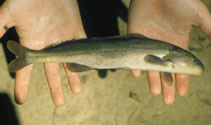| Family: |
Mormyridae (Elephantfishes) |
| Max. size: |
50 cm SL (male/unsexed); max.weight: 1,115.0 g |
| Environment: |
demersal; freshwater, potamodromous |
| Distribution: |
Africa: Nile and Chad basins. Known from the great Sahelo-Soudanian basins in Senegal, Gambia and Volta; also in the Mono, the Gêba, the Bandama, the Comoe River, and the Ebrie and Aguien lagoons (Ref. 2915). |
| Diagnosis: |
Dorsal spines (total): 0-0; Dorsal soft rays (total): 63-82; Anal spines: 0-0; Anal soft rays: 16-20. Diagnosis: snout short, its length about 50% of the post-ocular length of the head (Ref. 28714), prominent, but not drawn out into a proboscis (Ref. 2915, 81274). Dorsal fin with 63-82 rays, beginning clearly in advance of pelvic fins; anal with 16-20 rays, its base comprised from 4.1 to 6.3 times in dorsal-fin base (Ref. 81274). Caudal peduncle relatively deep, its depth comprised 1.1-2.0 times in its length (Ref. 2915, 81274). 26-34 scales around caudal peduncle; ratio standard length/body depth: 4.2-6.2; upper jaw with 6-16, lower jaw with 10-22 teeth (Ref. 81274).
Description: dorsal fin very long, more than twice the anal fin length (Ref. 28714).
Coloration: ground color silvery, occasionally grading to a more or less dark grey; back darker, greyish-yellow, greenish or blackish; belly white, whitish-yellow or pale grey (Ref. 2915, 81274). |
| Biology: |
Possesses electroreceptors over the entire head and on the ventral and dorsal regions of the body, but absent from the side and the caudal peduncle where the electric organ is located (Ref. 10011). A fractional spawner (Ref. 10605; 10606). |
| IUCN Red List Status: |
Least Concern (LC); Date assessed: 24 October 2019 Ref. (130435)
|
| Threat to humans: |
harmless |
Source and more info: www.fishbase.org. For personal, classroom, and other internal use only. Not for publication.
